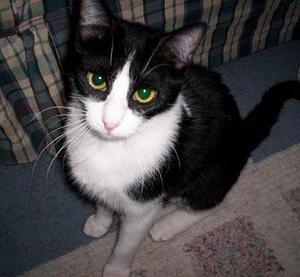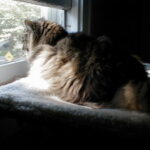Lymphocytic/plasmacytic Gingivitis Stomatitis (LPGS) is a disease unique to cats. It can be serious in some cases but there are treatments that can help. This disease is most common in older cats, but can occur in younger cats. My 2 year old cat, Kiley, was tentatively diagnosed with LPGS last month.
The first symptom I noticed was her bad breath. A cat’s breath doesn’t exactly smell of roses on a good day, but a foul smell is often a sign that something is amiss. I noted to myself that I needed to make an appointment for her, but I wasn’t too worried yet. Then her symptoms rapidly progressed to swollen glands beneath her chin and the foul breath worsened. She lost her appetite as well and, fearing some kind of cancer, I became alarmed. I tried to look in her mouth but she resisted and it was obvious she was in pain. A call to the veterinarian was in order.
It did not take the veterinarian very long to decide Kiley likely had LPGS. That day the vet gave Kiley a steroid shot and put her on amoxicillin. Within a couple of days the swelling in the glands had diminished significantly and she was beginning to feel better. Like most cats with LPGS, Kiley will eventually go in for a cleaning and she may have to have teeth removed.
When I arrived home from the veterinary clinic that day, I researched LPGS to find out more about this serious form of feline gingivitis. The veterinarian had given me quite a bit of information already but I wanted to know more about what Kiley and I were up against.
Symptoms of Lymphocytic/plasmacytic Gingivitis Stomatitis:
Kiley did not display all the symptoms. She did not paw at her mouth or drool excessively. Pawing and drooling are two common symptoms but cat owners should not assume the cat does not have LPGS just because those symptoms aren’t present. Bad breath and loss of appetite, which Kiley did have, are also symptoms to watch for.
Causes of LPGS:
The exact causes of Lymphocytic/plasmacytic Gingivitis Stomatitis are unknown, but it is believed to be auto-immune related. The immune system reacts to the cat’s dental plaque and possibly even the teeth (the dentin)—which is why removing the teeth often helps.
Some feline viruses, such as feline leukemia virus, feline immunodeficiency virus (FIV) and calicivirus, are believed to be contributing factors in some cats.
Treatment for Lymphocytic/plasmacytic Gingivitis Stomatitis:
The mouth inflammation is most commonly treated with steroids. Antibiotics are prescribed to get rid of any infection. Hypoallergenic diets or other special diets are often recommended because food additives may trigger lymphocytic/plasmacytic gingivitis stomatitis.
Dental rinses containing Chlorhexidin can help the LPGS cat by reducing bacteria and plaque. Brushing the teeth with feline toothpaste is also recommended.
As I stated earlier, when the disease does not respond well to other measures ( cleaning, change of diet, steroids and antibiotics) the teeth, except for the canine teeth, are removed.
Kiley is doing fairly well so far. She has regained energy and her appetite is better. I know we aren’t out of the woods yet. She may still lose her teeth. From what I’ve read, though, most cats handle that well and are able to live relatively normal lives afterwards.
If your cat has been diagnosed with lymphocytic/plasmacytic gingivitis stomatitis, take heart. It can be serious but, with good care, many cats can still live happy lives.





